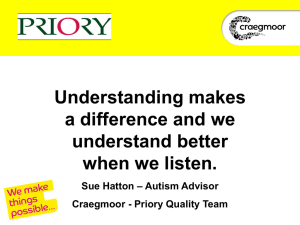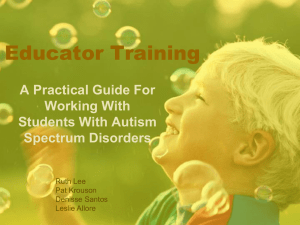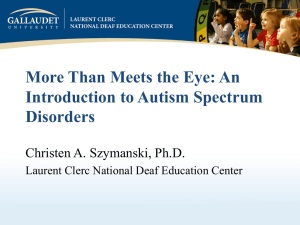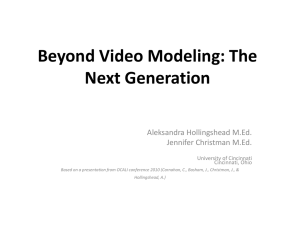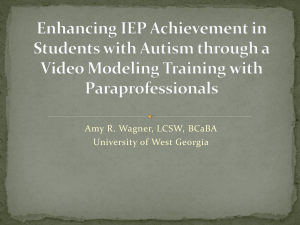Describing Autism...Cognitive Processes 11.28.12
advertisement
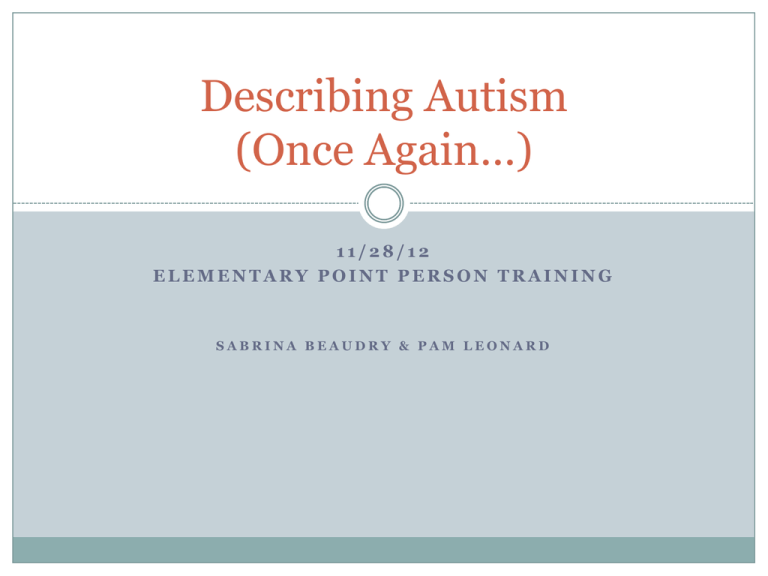
Describing Autism (Once Again…) 11/28/12 ELEMENTARY POINT PERSON TRAINING SABRINA BEAUDRY & PAM LEONARD Today we will be Describing ASD… We will review some DSM V information We will take a look at personal accounts as a way to describe autism We will examine the 3 cognitive processes that impact individuals with ASD We will talk about the challenges due to differences in these 3 cognitive processes Get into groups to discuss “Action Plan” implementation (from Walk Throughs) Describing Autism We know much more now than we did 10 years ago. It is not as helpful to think of our students with ASD as high functioning or low functioning but rather how they think. As we broaden our knowledge about ASD, it helps us understand the incredible variability of how our students’ autism is manifested. Different Ways To Describe Autism: 1. Traditional Medical Model-DSMIV-TR 2. Information from people on the spectrum themselves 3. Psychological Model/ Brain Based Theories (Cognitive Processes) Traditional Diagnostic Model DSM-IV-TR – soon to be DSM-V ( May of 2013) Most introductions to autism cite the DSM-IV-TR diagnostic criteria as a description of autism, but that is misleading because it is a diagnostic tool and not a descriptive tool. That means it doesn't really tell us what autism is, just how to decide if a person has autism or not. (OCALI module Employee with Autism). Presently to receive a medical diagnosis of Autism or Asperger’s Syndrome, one must meet certain criteria in the following three areas: AUTISM Communication Social Interaction Restricted Interest/Repetitive Behaviors This will be changing in 2013 The DSM V has changed the diagnostic criteria and it will be called Autism Spectrum Disorders The original three domains will become two Social/Communication Disorder Fixated Interests and Repetitive Behaviors There will be three levels of severity Why Change? To have more consistency and clarity of diagnosis Autism is defined by a common set of behaviors and so it makes sense to have a single diagnostic category It is better to look at Autism as a spectrum rather than as an umbrella term related to several distinct diagnosis What does this change mean? Catherine Lord, Ph.D. looks at the change in the following manner during an interview with CBS: “ The intention of changing the DSM …is not to exclude those that already have been diagnosed, but to better define the condition.” More Info on DSMV: http://www.socialthinking.com/index.php?option=c om_content&view=article&id=559:dsm-5-mythoughts&catid=76:michellesblog&Itemid=121&utm_source=april++providers&utm_campaign=Newsletter&utm_medi um=email Power point Presentation from Little Friends More Info on DSMV: http://www.dsm5.org/Pages/Default.aspx http://www.autismspeaks.org/site-wide/dsm-v https://www.aucd.org/docs/SIG%20Docs/autismsig/ Dr.Lord_3_18_11_webinar.pdf Another way to Describe ASD…Personal Accounts Ask individuals with Autism: How they feel about their autism How autism impacts them individually What helps them What they wish other people understood What People with Autism Told Olney in 2000 Primary Areas of Challenge: Sensation Attention Emotion Time and Place Coping (Adult Autism & Employment, Scott Standifer Ph.D) Some Quotes: “I loved repetition. Every time I turned on a light I knew what would happen. When I flipped the switch, the light went on. It gave me a wonderful feeling of security because it was exactly the same each time.” –Sean Barron “I learned to talk at 4. I didn’t learn to communicate until 11 or 12.”-Bill Donovan “I wanted to understand emotions. I had dictionary definitions for most of them and cartoon caricatures of others…I also had trouble reading what other people felt.”-Donna Williams “I was never quite sure how to handle certain situations. It is very difficult…to know exactly when to say something when to ask for help, or when to remain quiet…Life is a game in which the rules are constantly changing without rhyme or reason.”-Anne Carpenter What Would Your Student Say? How does autism impact you in the following ways? Sensation Attention Emotion Time and Place Coping A Third Way to Describe ASD… Cognitive processes Theory of Mind Executive Functioning Central Coherence Theory of Mind: Refers to a person’s ability to think about people’s thinking This typically is developed by the age of four This is the ability that allows us to take the perspective of others and adjust our behavior according to that perspective Challenges related to Theory of Mind: Social communication Language comprehension Perspective taking Literal interpretation of language Intensive interests in topic Engaging in shared experiences Predicting difficulties Understanding how/why a character behaves Affects listening comprehension Resources ..\Psychological Model Info\Autism and Theory of Mind.docx ..\Psychological Model Info\TOM-in-TD-and-ASD.pdf ..\Psychological Model Info\423-tager-flusbg07.pdf ..\Psychological Model Info\2011-Convention- Presentation-ToM-Assessment-ASD.pdf Executive Functioning: This is the ability to use problem solving skills for: Planning/organization Self monitoring Controlling our impulses Being flexible thinkers Organizing our thoughts Challenges related to Executive Function Repetitive behaviors Restricted patterns & interests Attention issues Memory for details Organization challenges Planning Difficulty inhibiting responses/impulses Difficulty applying relevant knowledge across texts Monitoring and self-correcting comprehension is difficult Resource http://www.asha.org/Publications/leader/2010/101 221/Executive-Functions-and-Communication-inAdolescents.htm Central Coherence: This allows us to take various pieces of information and put it together to create the “whole picture” It is the skill that allows us make sense of information from the context Challenges related to Central Coherence: Focus on specific details vs. big picture Students with ASD may prefer their perspective over others Makes students like to keep things the same Results in trouble making connections and generalizing Difficulty making meaning from text using important details Difficulty making connections (between words, concepts, experiences) As text becomes longer, becomes more difficult to make meaning Resources ..\Psychological Model Info\core_deficits.pdf Big Picture Thinking-Using Central Coherence Theory to Support Social Skills by Aileen Zeitz Collucci http://www.aapcpublishing.net/book/view/677/big-picturethinking-using-central-coherence-theory-to-supportsocial-skills The Weak Coherence Account: Detail-focused Cognitive Style in Autism Spectrum Disorders: http://www.ucp.pt/site/resources/documents/ICS/GNC/Arti gosGNC/AnaMariaAbreu/D_HaFr06.pdf In the Past…… We observed and described ASD based on the DSM- IV descriptors. Now let’s describe our students in relation to deficits in the three cognitive processes areas. Theory of Mind Executive Function Central Coherence Using the handout that outlines challenges… We will pick a student and: list four of his/her challenges describe these challenges when we observe (what does it look like?) determine which cognitive process/processes each challenge stems from EXAMPLE Challenges that are impacting your student What does the student do that shows you the challenges Social Communication Student always interrupts others when they are talking/ Takes over any conversation with focus on their topic of interest Trouble making connections and generalizing/Difficulty applying relevant knowledge across texts When reading a novel, can’t make connection between something they learned in social studies and what is happening in the novel Poor perspective taking/Prefer their perspective over others Gets upset when someone doesn’t agree with him Repetitive behaviors Always has to clap three times before starting an assignment Cognitive Process? Student_________: Challenges that are impacting your student What does the student do that shows you the challenges Cognitive Process? Social communication Converses primarily with adults. Theory of Mind Enjoys talking about Dell computers/ info from manuals or about Hyundi cars Why did we do this? There is a lot of brain based research going on right now. We presented this to high school & middle school groups and didn’t want you to be left out Important in terms of how we think of assessment Important in terms of how we provide supports across all domain areas. So in February We will continue by discussing ways to support students using their input. We will discuss ways to support the 3 areas of cognitive differences. We will discuss how to directly instruct students in using strategies that help them think differently.





